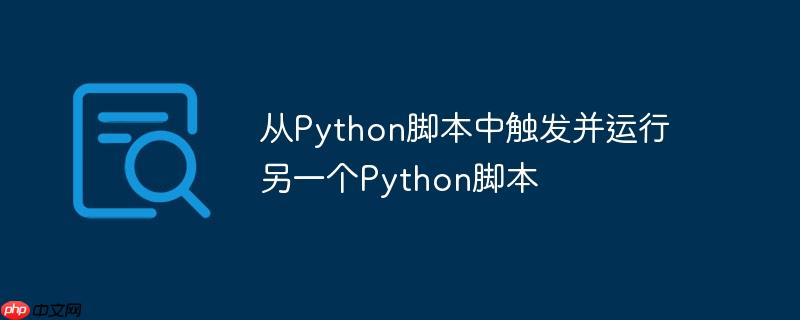
在Python编程中,有时我们需要在一个脚本中调用并执行另一个脚本。这种情况可能出现在需要模块化大型项目,或者需要将某些耗时任务交给独立的子进程处理时。本文将介绍如何使用subprocess模块来实现这一目标,并确保主脚本可以继续执行后续代码。
正如摘要所述,我们将重点关注subprocess模块的使用,并详细讲解如何构建完整的脚本路径以及获取Python解释器路径。
subprocess模块允许你创建新的进程,连接到它们的输入/输出/错误管道,并获取它们的返回码。它是Python中执行外部命令的首选方式。
首先,我们需要确定Python解释器的路径。这可以通过shutil.which("python")来实现。
立即学习“Python免费学习笔记(深入)”;
import shutil
import os
py_bin = shutil.which("python")
print(f"Python interpreter path: {py_bin}")这段代码会查找系统中名为 "python" 的可执行文件,并返回其完整路径。如果找不到,则返回 None。
为了确保子进程能够找到要执行的Python脚本,我们需要构建脚本的完整路径。这可以通过os.path.join()和os.path.dirname(os.path.realpath(__file__))来实现。
project_root = os.path.dirname(os.path.realpath(__file__))
process_1_path = os.path.join(project_root, 'process_1.py')
print(f"Full path to process_1.py: {process_1_path}")os.path.dirname(os.path.realpath(__file__)) 获取当前脚本所在的目录,然后 os.path.join() 将目录和文件名连接起来,形成完整的路径。
同步执行意味着主脚本会等待子进程执行完毕后再继续执行后续代码。这可以通过subprocess.run()来实现。
import subprocess
import shutil
import os
# Get Current files full path
project_root = os.path.dirname(os.path.realpath(__file__))
# Build full path to the proccess_1 file.
process_1_path = os.path.join(project_root, 'process_1.py')
# Get path to python executable
py_bin = shutil.which("python")
# Run the file and wait for it to finish.
subprocess.run([py_bin, process_1_path])
print("process_1.py finished, continuing with main script.")subprocess.run([py_bin, process_1_path]) 会启动 process_1.py 脚本,并等待其执行完成。只有当 process_1.py 结束运行时,才会打印 "process_1.py finished, continuing with main script."。
异步执行意味着主脚本不会等待子进程执行完毕,而是立即继续执行后续代码。这可以通过subprocess.Popen()来实现。
import subprocess
import shutil
import os
# Get Current files full path
project_root = os.path.dirname(os.path.realpath(__file__))
# Build full path to the proccess_1 file.
process_1_path = os.path.join(project_root, 'process_1.py')
# Get path to python executable
py_bin = shutil.which("python")
# Run the file in background and continue this script's execution
main_code_process = subprocess.Popen([py_bin, process_1_path])
print("process_1.py started in background, continuing with main script.")
# You can later wait for the process to finish if needed:
# main_code_process.wait()
# print("process_1.py finished.")subprocess.Popen([py_bin, process_1_path]) 会启动 process_1.py 脚本,但主脚本不会等待其执行完成,而是立即打印 "process_1.py started in background, continuing with main script."。如果你需要等待子进程完成,可以调用 main_code_process.wait()。
通过使用subprocess模块,我们可以方便地从一个Python脚本中触发并运行另一个Python脚本。subprocess.run() 用于同步执行,subprocess.Popen() 用于异步执行。通过获取Python解释器路径和构建完整的脚本路径,可以确保子进程能够正确执行。在实际应用中,需要注意路径、权限、环境变量和错误处理等问题,以确保程序的稳定性和可靠性。
以上就是从Python脚本中触发并运行另一个Python脚本的详细内容,更多请关注php中文网其它相关文章!

每个人都需要一台速度更快、更稳定的 PC。随着时间的推移,垃圾文件、旧注册表数据和不必要的后台进程会占用资源并降低性能。幸运的是,许多工具可以让 Windows 保持平稳运行。

Copyright 2014-2025 https://www.php.cn/ All Rights Reserved | php.cn | 湘ICP备2023035733号